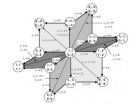The new study by computational biologists at Rice and experimental biologists at the University of Houston is available online in the Proceedings of the National Academy of Sciences.
"The gene-expression program that B. subtilis uses to form spores involves hundreds of genes," said Oleg Igoshin, lead scientist on the study and professor of bioengineering at Rice. "Many of these genes are known and have been studied for decades, but the exact mechanism that B. subtilis uses to make the decision to form a spore has remained a mystery."
B. subtilis is a common soil bacterium that forms a spore when food runs short. Spore formation involves dramatic changes. The cell first asymmetrically divides within its outer wall, forming one large chamber and one small one. As spore formation progresses, one chamber envelopes the other, which becomes a vault for the organism's DNA and a small set of proteins that can "reboot" the organism when it senses that outside conditions have improved.
B. subtilis is harmless to humans, but some dangerous bacteria like anthrax also form spores. Scientists are keen to better understand the process, both to protect public health and to explore the evolution of complex genetic processes.
During spore formation, scientists know that a bacterium channels its energy into producing proteins that help prepare the cell to become a spore. Many of these spore-forming proteins are required in a specific sequential order, and some are "master regulators," proteins that initiate and control entire subroutines of the spore-forming program.
"Sporulation is a complex and mysterious process," Igoshin said. "For example, some cells choose to become spores and others don't -- even if they are exposed to the same conditions. Even more intriguing is the fact that some cells begin the process of converting into spores only to turn back and revert to normal behavior."
To decipher how B. subtilis decides to form a spore, Igoshin and Rice graduate student Jatin Narula created a set of sophisticated computer models that recreated the organism's genetic controls. The results from the computer model were compared and refined based on experimental observations by UH's Masaya Fujita and Seram Devi.
"The master regulator Spo0A is responsible for kicking off the process of spore formation, and our initial hypothesis was that this was the key player involved in the decision to become a spore," Igoshin said. "We found that the decision-making process was considerably more complex."
Signal processing in bacteria is complicated because the amount of information that their network can receive and process is related to the number of molecules inside the cells. The tiny size of the bacterial cell therefore leads to very noisy signals. The problem is akin to the challenge a political pollster would face in attempting to predict the outcome of a national election based on interviews with only 50 voters.
"It's a statistical sampling problem," Igoshin said. "Because the bacterial cell is small, master regulator genes have to contend with very noisy signals. One way to overcome the problem is to average the signals over a long period of time. We examined whether B. subtilis did this in making the decision to form a spore, but we found that if the cell waited for a clear signal, it may not complete the complicated spore-forming program before it would die."
Instead, the cell kicks off the spore-forming process and begins making preparations, even as it continues to perform its statistical sampling. The paper's authors found that a key to this process is a series of nested "feedforward" loops -- network motifs in which one master regulator controls another by directly regulating its amount and indirectly regulating its activity.
"Cells have an ingenious strategy, which allows them to change their mind and process information while they are executing the program," Narula said. "This strategy allows them to make an accurate decision without delaying their decision just to average noisy signals."
###
The research was supported by the National Science Foundation and the Howard Hughes Medical Institute. The computer modeling was performed on two NSF-funded Rice supercomputers -- STIC and DAVinCI -- that are jointly managed and operated by Rice's Ken Kennedy Institute for Information Technology and Rice's Department of Information Technology.
High-resolution images are available for download at: http://news.rice.edu/wp-content/uploads/2012/11/1130_SUBTILIS_cells-lg.jpg
CAPTION: New research finds the bacterium Bacillus subtilis begins preparing for survival in hard times, even as it delays the ultimate decision of whether to form a spore. Researchers used fluorescent labels to measure the production of spore-forming genes. This image shows a heterogeneous population of starving bacterial cells that includes both non-sporulating cells (dark blue) and cells that have begun spore-formation by dividing asymmetrically into large (yellow) and small (pink) chambers.
CREDIT: M. Fujita/UH
http://news.rice.edu/wp-content/uploads/2012/11/1130_SUBTILIS_draw2-lg.jpg
CAPTION: Rice University computational biologists Oleg Igoshin (left) and Jatin Narula sketch the elaborate signal processing mechanism that the bacteria B. subtilis use to decide whether to form a spore.
CREDIT: Jeff Fitlow/Rice University
A copy of the PNAS paper is available at: http://www.pnas.org/cgi/doi/10.1073/pnas.1213974109
Follow Rice News and Media Relations via Twitter @RiceUNews
Located on a 300-acre forested campus in Houston, Rice University is consistently ranked among the nation's top 20 universities by U.S. News & World Report. Rice has highly respected schools of Architecture, Business, Continuing Studies, Engineering, Humanities, Music, Natural Sciences and Social Sciences and is home to the Baker Institute for Public Policy. With 3,708 undergraduates and 2,374 graduate students, Rice's undergraduate student-to-faculty ratio is 6-to-1. Its residential college system builds close-knit communities and lifelong friendships, just one reason why Rice has been ranked No. 1 for best quality of life multiple times by the Princeton Review and No. 2 for "best value" among private universities by Kiplinger's Personal Finance. To read "What they're saying about Rice," go to http://tinyurl.com/AboutRice.
END

